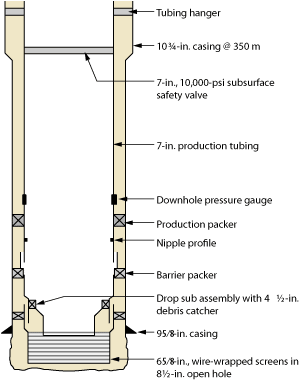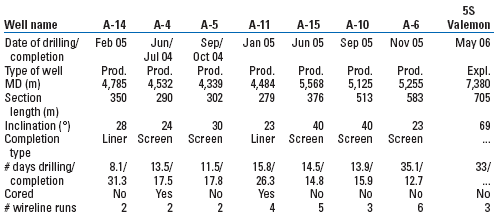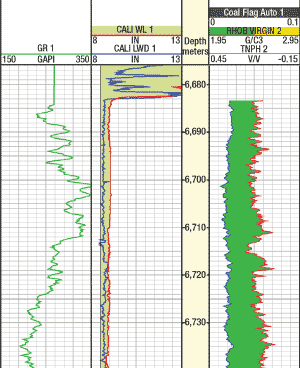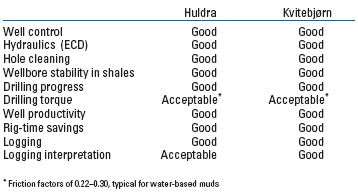Statoil drilled 13 and completed 20 HPHT development wells with cesium formate brines without a single well-control incident. Wells drilled with the fluid are highly productive with low skins. Low ECD has been a notable feature in all operations.
John Downs, Cabot Specialty Fluids
Formate brines have a long history of successful use as reservoir drill-in, completion, workover and suspension fluids in High Pressure/High Temperature (HPHT) well construction operations. These applications have included about 120 cases in which high downhole pressures have necessitated the use of cesium formate brines for well control purposes. With its superior HSE profile and low corrosiviness, cesium formate has proven to be an excellent replacement for the traditional zinc bromide brine, and is now the only high-density (i.e., specific gravity greater than 1.72) clear brine completion fluid used in North Sea HPHT wells.
Statoil (now StatoilHydro) has deployed cesium formate brines as well construction fluids in 57 HPHT operations in the North Sea since early 2001, including the drilling and completion of the reservoir sections of 13 high-angle HPHT development wells in Huldra and Kvitebjørn Fields. Statoil selected and pioneered the use of cesium formate brines as combined drilling and completion fluids after field experience in their HPHT wells had shown that conventional fluids were creating safety risks and causing concern about screen plugging.
A review of cesium formate brine performance over the past seven years in Huldra and Kvitebjørn Fields suggests that they have effectively provided the fluid solution to minimizing HPHT well control problems and maximizing well productivity. Formation evaluation in HPHT wells drilled with cesium formate brine has been aided by the operator’s development of a novel logging interpretation solution for an LWD density tool in which the extremely high photoelectric effect of cesium-rich filtrate plays a vital role. Applying this interpretation to data from LWD drill passes and ream passes has produced very reliable and consistent net reservoir definition.
HPHT FIELD DEVELOPMENTS
The company manages a complex portfolio of offshore fields in Norway ranging from mature assets such as Gullfaks to frontier HPHT developments such as Huldra and Kvitebjørn. The latter projects, conducted over the past seven years, have been particularly demanding and have required the operator to use the most advanced technologies.1
Huldra. Huldra is a semi-HPHT gas/condensate field located north of Oseberg in 125 m of water.2 The reservoir lies at a depth of 3,500-3,900 m and consists of Jurassic sandstones in the Brent group. It is classified as high temperature (150°C/302°F) and on the border of high pressure (9,790 psi). The difference between the original pore pressure and fracture pressure gradient was small in the reservoir (specific gravity 0.12-0.14). The Huldra gas stream contains 3-4% CO2 and 9-14 ppm H2S. Platform development drilling of the first of six production wells commenced in 2001. The wells were drilled at a 45º-55º inclination through the reservoir and completed openhole with 300-micron, 65/8-in. single-wire-wrapped screens. A schematic view of a typical Huldra completion is shown in Fig. 1.
 |
|
Fig. 1. Schematic view of a typical Huldra completion.
|
|
Kvitebjørn. This field is an HPHT gas/condensate field under development in Block 34/11 located in 190 m of water in the southeastern part of the Tampen Spur area.3 The field sits on a down-faulted rotated block flanked by the Gullfaks Sør and Gullfaks Fault Blocks in the west and the North Viking Graben in the south, east and northeast.
The Brent Group is a deltaic deposit, comprising interbedded sand, shale and coal layers. The heterogeneous Brent Group sequence has a thickness of about 160-190 m in Kvitebjørn Field. The reservoir lies at about 4,000 m and is classified as high temperature (155°C/311°F) and high pressure (11,700 psi). The Kvitebjørn gas contains 2-3% CO2 and up to 10 ppm H2S.
Development drilling of the first of 11 production wells commenced in June 2004. To date, seven of the 11 planned production wells have been drilled and completed, all with inclinations varying from 20° to 45°. Five of the seven wells have been completed openhole with sand screens (Fig. 1) and two with cemented liners. Production commenced following drilling of the first two wells. The remaining well construction program is taking place in an environment of progressive reservoir pressure depletion.
DRILLING FLUID CHALLENGE
The key objective of the drilling and completion process is to safely deliver high-quality wells that are optimized in terms of providing shareholder value. The choice of drilling and completion fluid used in a well construction operation has a critical influence on the extent to which this objective can be met. The fluid’s performance plays a significant part in determining whether or not operators meet or exceed their Key Performance Indicator (KPI).
If the drilling fluid is to be used in reservoir sections without further intervention, it must result in minimal change to the native permeability of the reservoir rock in the near-wellbore region. The drilling fluid filtrate also must be compatible with other filtrates that might leak off from subsequent cementing and completion operations. A completion fluid should have the same overall properties as a reservoir drill-in fluid and, ideally, should be the same fluid minus any drilled solids.
The extreme conditions in Huldra and Kvitebjørn appeared to pose a challenge for conventional drilling and completion fluids. High downhole temperatures can degrade the barite-carrying capacity of conventional muds, causing both dynamic and static barite sag and increasing the risk of well control events in high-angle wells. Oil-Based Mud (OBM) can absorb large volumes of gas, and this also may cause well control problems if the muds remain static for long periods in long horizontal holes. Furthermore, an influx of hydrocarbon gas into OBM may destabilize the formulation and cause barite sag. OBMs can dissolve several orders of magnitude more gas than water-based fluids.
Laboratory return permeability tests conducted on samples of a range of conventional barite-weighted drilling muds taken directly from the field show that they can cause considerable formation damage.4 The presence of very high levels of barite in high-weight muds formulated for high-pressure wells does not improve matters. The openhole sand screens used in the completion of the Huldra and Kvitebjørn wells are susceptible to plugging by mud solids such as regulation API-size barite. High-density drilling muds containing high levels of solids are known to reduce penetration rates in hard abrasive sandstones and may increase bit wear.
The use of Corrosion-Resistant Alloys (CRA) in HPHT wells has been exposing fundamental flaws in the performance of conventional completion fluids based on chloride and bromide brines. It is well documented that severe localized corrosion and stress corrosion cracking of CRA tubulars will take place in HPHT wells if they are exposed to chloride and bromide brines containing oxygen, CO2 or H2S.5-11 Also, the sulfur-containing corrosion inhibitors commonly used in halide brines are known to decompose to H2S at high temperatures and create another source of stress corrosion cracking.12
CESIUM FORMATE BRINE FIELD EXPERIENCE
Statoil has deployed cesium formate brines as well construction fluids in 57 HPHT operations in the North Sea, setting North Sea HPHT drilling and completion records. No well control incidents were experienced. The published field experiences from the past seven years are summarized.2,3
Huldra. Cesium formate brine of 1.91 specific gravity was used to drill and complete the reservoir sections of six wells in the Huldra field during 2001 and 2002. The average section length was 212 m, and overall brine losses averaged 160-190 bbl per well.
The drilling operations were characterized by good hole stability, low ECD and good hole cleaning. The excellent rheology and thermal stability of the drilling fluid led to rig-time savings from faster tripping speeds, faster casing-running speeds, less mud conditioning and fewer wiper trips. The ROP was considered to be good at 10 m/hr.
The drilling fluid was circulated over a combination of 250-, 300- and 400-mesh shaker screens before the completion screens were run. After running the screens, the drilling fluid was replaced with filtered cesium formate completion brine. The use of the same fluid system for both drilling and completion provided the additional benefits of simplified operations, reduced waste and elimination of fluid incompatibility problems.
Kvitebjørn. Cesium formate brine of 2.02 specific gravity was used to drill, core, complete and log the 8½-in. reservoir sections of six Kvitebjørn wells during 2004-2007, Table 1. The section lengths were 279-583 m (24°-40° deviation). Overall brine loss during the drilling phase was typically 410 bbl per well. Tripping losses were about 6.3 bbl/trip. An extended-reach exploration well was also drilled with cesium formate brine from the Kvitebjørn platform to the Valemon structure. This 7,380-m well (69° inclination) included a 705-m reservoir section.
| TABLE 1. Wells drilled and completed from the Kvitebjørn platform using cesium formate brine |
 |
|
The drilling performance was generally very good with low ECD, moderate to high ROP, good hydraulics, no stuck-pipe incidents, low torque and drag, and excellent hole cleaning. Wellbore stability in the long sections of interbedded shales was good, and there were no major washouts. Figure 2 shows the caliper and gamma-ray data for a Draupne overburden shale section in the Valemon exploration well. The borehole had been open for 30 days between running the original LWD log and the later wireline log. Even after a few weeks of openhole in Kvitebjørn and Valemon, hole sizes over 9½ in. have been very rare, both in intra-reservoir shales and in overburden shales.
 |
|
Fig. 2. Mechanical caliper (CALI_WL) run in the Valemon exploration well 30 days after LWD ultrasonic caliper (CALI_LWD) in the overburden hot shale of the Viking Group and into the rat hole (6,683 m). Well inclination of 63°.
|
|
Quick, trouble-free, safe and robust completion operations were also accomplished, and the wells show high production rates with low skin. A record was set for the fastest HPHT well completion in the North Sea (12.7 days).
Full openhole formation evaluation of the Kvitebjørn reservoir was carried out with LWD tools. The evaluation has been aided by the development of a novel logging interpretation solution for an LWD density tool in which the extremely high photoelectric effect of cesium-rich filtrate plays a vital role. Using photoelectric factor and bulk density data combined with resistivity measurements from the LWD drill pass and ream pass produces a very reliable and consistent net reservoir definition. The final interpretation result matches the core porosity from different lithologies in three different wells.
The use of cesium formate brine for drilling provided the possibility of running high-quality resistivity image logs.
CONCLUSION
The original and key drivers for using cesium formate brines as the drill-in fluids on Huldra were to eliminate well control problems caused by barite sag in high-angle HPHT wells, provide low ECD and minimize formation damage and screen plugging. An assessment of how the formate brines performed in Huldra and, subsequently, in one other HPHT field suggests that they fulfilled all expectations in this respect, Table 2.
| Table 2. Assessments of formate brine performance in Huldra and Kvitebjørn Field developments |
 |
|
Generally, drilling, coring, completing and logging operations on Huldra and Kvitebjørn went well and led to rig-time savings. The formate brines delivered stable and close-to-gauge holes. The logging interpretation quality improved dramatically once the new interpretation solution was developed. 
LITERATURE CITED
1 Hsieh, L., “Evolving frontiers-Change is coming and Statoil wants to be an implementer, not a follower,” Drilling Contractor, July/August 2007, pp. 21-27.
2 Saasen, A. et al., “Drilling HT/HP wells using a cesium formate based drilling fluid,” SPE 74541 presented at the IADC/SPE Drilling Conference, Dallas, Feb. 26-28, 2002.
3 Berg, P. C. et al., “Drilling, completion and openhole formation evaluation of high-angle wells in high density cesium formate brine: the Kvitebjørn experience, 2004-2006,” SPE 105733 presented at the SPE/IADC Drilling Conference,
Amsterdam, Feb. 20-22, 2007.
4 Francis, P. A., Eigner, M. R. P., Patey, I. T. M. and I. S. C. Spark, “Visualization of drilling-induced formation damage mechanisms using reservoir conditions core flood testing,” SPE 30088 presented at the SPE European Formation Damage Conference, The Hague, May 15-16, 1995.
5 Sutanto, H. and C. A. W. Semerad, “Annulus corrosion in high temperature gas wells,” SPE Production Engineering, August 1990, pp. 295-298.
6 Ibrahim, M. Z. et al., “Corrosion behavior of S13Cr martensitic stainless steel in completion fluid,” Corrosion/2003 03097 presented at NACE International, Houston, 2003.
7 Silverman, S. A., Bhavsar, R., Edwards, C., Virally, S. and W. Foxenberg, “Use of high strength alloys and elastomers in heavy completion brines,” SPE 84515 presented at the SPE Annual Technical Conference & Exhibition, Denver, Colorado, Oct. 5-8, 2003.
8 Stevens, R., Ke, M., Javora, P. H. and Q. Qu, “Oilfield environment-induced stress corrosion cracking of corrosion resistant alloys in completion brine,” SPE 90188 presented at the SPE Annual Technical Conference & Exhibition, Houston, Sept. 26-29, 2004.
9 Craig, B. D. and C. M. Webre, “Stress corrosion cracking of corrosion resistant alloys in brine packer fluids,” SPE 93785 presented at the 2005 SPE Production and Operations Symposium, Oklahoma City, April 17-19, 2005.
10 Leth-Olsen, H., “CO2 corrosion in bromide and formate well completion brines,” SPE 95072 presented at the SPE 2nd International Symposium on Oilfield Corrosion, Aberdeen, May 13, 2005.
11 Downs, J. D. and H. Leth-Olsen, “Effect of environmental contamination on susceptibility of corrosion resistant alloys to stress corrosion cracking in high-density completion brines,” SPE 100438 presented at the SPE 2006 Oilfield Corrosion Symposium, Aberdeen, May 30, 2006.
12 Mack, R., Williams C., Lester, S. and J. Casassa, “Stress corrosion cracking of cold worked 22Cr duplex stainless steel production tubing in high density clear brine CaCl2 packer fluids,” Corrosion/2002 02067 presented at NACE International, Houston, 2002.
|
THE AUTHOR
|
|
|
John Downs is technical sales director for Cabot Specialty Fluids. He joined Shell in 1973 and spent 22 years working on the development and commercialization of a range of novel well construction chemicals including formate brines and clouding glycols. Downs was appointed managing director of Forbrico, the first formate brine service company, in 1995 before joining Norsk Hydro as global business manager for the company’s formate brines business. In 2004 he joined Cabot Specialty Fluids, which specializes in the provision of high-density cesium formate brines for HPHT well construction projects. Downs has a BSc degree in microbiology from the University of Bath and has written or co-authored 15 technical papers on formate brines.
|
|







